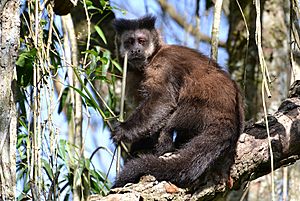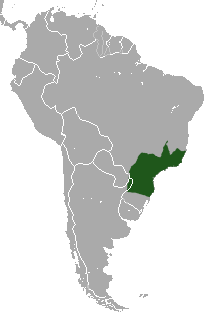Black capuchin facts for kids
Quick facts for kids Black capuchin |
|
|---|---|
 |
|
| Black capuchin in Argentina | |
| Conservation status | |
| Scientific classification | |
| Genus: |
Sapajus
|
| Species: |
nigritus
|
 |
|
| Combined range of S. n. nigritus and S. n. cucullatus. S. n. robustus is found just northeast of this range (see text). | |
The black capuchin (Sapajus nigritus) is a type of capuchin monkey. It is also known as the black-horned capuchin. These monkeys live in the Atlantic Forest in south-eastern Brazil and far north-eastern Argentina. Scientists once thought it was a subspecies of the tufted capuchin.
Contents
About the Black Capuchin
The black capuchin was first given the scientific name Cebus nigritus. Even today, some books and websites might still use Cebus in its name. Its current scientific name is Sapajus nigritus.
Social Life and Behavior
Living in Groups
Black capuchins are very social animals. They love to live in groups, usually with 6 to 20 members. These groups have a clear pecking order, like a family with a leader. There are often more females than males in a group. But the main female (alpha female) usually follows the main male (alpha male).
The size of their group depends on how much food is around. When there's lots of food, groups are bigger and stick together more. If food is hard to find, they split into smaller groups. This helps them cover more ground to find food. This happens both during different seasons and over many years. Bigger groups need more food, so they have to travel further.
Female capuchins usually stay with the group they were born into. It's rare for a female to leave her family group. Males are much more likely to leave and find a new group. When a female does leave, she does it slowly. She first moves to the edge of the group before going off on her own.
How They Communicate
Black capuchins talk to each other in many ways. They use their bodies, faces, and different sounds. One special sound is called the 'scream embrace mechanism'. This is a high-pitched call often used by males to bring group members back together.
Building Friendships
Grooming is very important for black capuchins. It helps them stay clean, especially in places they can't reach themselves. But grooming also helps them make friends and build strong bonds. For example, lower-ranking monkeys can groom dominant monkeys. This helps them become friends and ease any tension.
Monkeys often groom others to get better access to food. Females might compete to groom the main female in the group. This is especially true if there's a clear female leader. But it's not common for monkeys of the same sex to groom each other. Male-male grooming is very rare. Female-female grooming happens less often too. When females do groom each other, it's usually when the group is very close. They also prefer to groom their relatives. Females more often groom males, especially the alpha male.
Grooming also changes based on who is in charge. Face-to-face grooming happens more often when the monkey doing the grooming is dominant. It also happens more if they are good friends with the monkey being groomed. The bigger the difference in their rank, the more likely they are to groom face-to-face.
Where They Live
Black capuchins live in the Atlantic region of north-eastern Argentina and south-eastern Brazil. Their home often overlaps with other capuchin species. They mostly live in trees, high up in the forest canopy. But they also come down to the forest floor to look for food. This is where they find lots of insects and nuts.
What They Eat
Black capuchin monkeys eat both plants and animals. This means they are omnivores. They eat many different things, like insects, bird eggs, small animals, leaves, bulbs, seeds, and fruits. What they eat mostly depends on what is available during different seasons. They are not picky eaters, but fruit can make up a huge part of their diet, sometimes three-quarters or more.
They like to try new foods, which helps them have a very varied diet. For example, one group of black capuchins ate 61 different kinds of fruit out of 145 available in their area. If they live in small forest areas without enough fruit, they might find food from farms nearby. They have been seen peeling bark from trees to eat the pine sap and inner layers.
Types of Black Capuchins
The black capuchin has three main types, called subspecies:
- Sapajus n. nigritus (the main type)
- S. n. cucullatus
These two types are found in the southern part of the black capuchin's home. S. n. nigritus lives more to the east, and S. n. cucullatus lives more to the west. Both of these types have two distinct tufts of hair on their heads. This is why they are also called black-horned capuchins.
- The third type is the crested or robust tufted capuchin (S. n. robustus). This type lives in the northern part of the species' range, north of the Doce River. It has a single, cone-shaped crest of hair on its head. Sometimes, scientists think this type might even be a separate species.
Conservation Status
We don't know exactly how many black capuchins there are, but their numbers are thought to be going down. This is mainly because their homes are being destroyed, they are hunted, and some are taken for the pet trade. However, these monkeys can sometimes survive in small, broken-up areas of forest.
The two southern types (S. n. nigritus and S. n. cucullatus) are still quite widespread. The IUCN (International Union for Conservation of Nature) lists them as Near Threatened. This means they could become endangered soon. The northern type (S. n. robustus) lives in a much smaller area and is considered Endangered.
See also
 In Spanish: Capuchino negro para niños
In Spanish: Capuchino negro para niños


